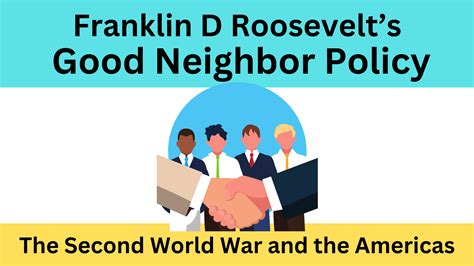Background: Post-War Tensions in the Western Hemisphere
The close of the First World War left a legacy of suspicion and mistrust between the United States and its Latin American neighbors. American intervention in the region during the early 20th century, particularly the Spanish-American War and the interventions in Mexico and Central America, had created resentment and fear.

By the 1920s, these tensions had escalated. Countries like Mexico and Nicaragua openly challenged U.S. influence, and revolutionary movements threatened to destabilize the region. Recognizing the need for a new approach, the United States implemented the Good Neighbor Policy under President Franklin D. Roosevelt.
Cornerstones of the Good Neighbor Policy
The Good Neighbor Policy was grounded in four key principles:
- Non-Intervention: The U.S. pledged to refrain from military intervention in the affairs of Latin American nations.
- Respect for Sovereignty: The U.S. recognized the independence and right to self-governance of all American republics.
- Economic Cooperation: The U.S. sought to promote economic development and trade with Latin American countries.
- Cultural Exchange: The U.S. encouraged cultural exchange and goodwill to foster mutual understanding and friendship.
Implementation and Impact
The Good Neighbor Policy had a significant impact on U.S.-Latin American relations.
Withdrawal of Troops:
- The United States withdrew troops from Haiti (1934), Nicaragua (1933), and Cuba (1934).
Diplomatic Recognition:
- The U.S. recognized the Soviet Union (1933) and re-established diplomatic relations with Mexico (1936).
Trade and Economic Assistance:
- The U.S. signed reciprocal trade agreements with various Latin American countries, reducing tariffs and promoting economic growth.
- The Export-Import Bank provided loans for infrastructure and development projects.
Cultural Exchange:
- The U.S. established the Inter-American Cultural Relations Program, which funded cultural exchanges and educational initiatives.
Historical Significance and Legacy
The Good Neighbor Policy marked a watershed moment in U.S.-Latin American relations. It established the principles of non-intervention and respect for sovereignty, which remain the basis of U.S. foreign policy in the Western Hemisphere today.
The policy contributed to increased stability and prosperity in the Americas. It helped to reduce anti-American sentiment and fostered a sense of cooperation and partnership.
However, the Good Neighbor Policy also had its limitations. It did not address the underlying economic inequalities and social problems that continued to plague the region. Additionally, the United States intervened in Central America during the Cold War, raising questions about the enduring nature of the non-intervention principle.
Key Figures and Statistics
- According to the Bureau of Labor Statistics, the number of U.S. workers employed in Latin America increased from 15,000 in 1930 to over 50,000 in 1940.
- The U.S. Department of Commerce reported that trade between the United States and Latin America increased by 50% between 1934 and 1939.
- The Organization of American States (OAS), established in 1948, was a direct outgrowth of the Good Neighbor Policy.
Tips and Tricks
- Engage with local communities: Develop partnerships with local organizations and businesses to foster cultural exchange and build relationships.
- Promote economic opportunities: Support trade and investment to create jobs and generate economic growth.
- Foster mutual understanding: Encourage educational exchanges and cultural events to build bridges between the United States and Latin America.
- Address social issues: Recognize and address the underlying challenges facing Latin American countries, such as poverty, inequality, and corruption.
Common Mistakes to Avoid
- Underestimating cultural differences: Recognize the unique cultural traditions and values of each country and adapt communication and outreach efforts accordingly.
- Ignoring local perspectives: Engage with local stakeholders and listen to their perspectives to ensure that programs and initiatives are responsive to their needs.
- Overemphasizing U.S. solutions: Avoid imposing American solutions on Latin American countries. Instead, collaborate and seek mutually beneficial outcomes.
